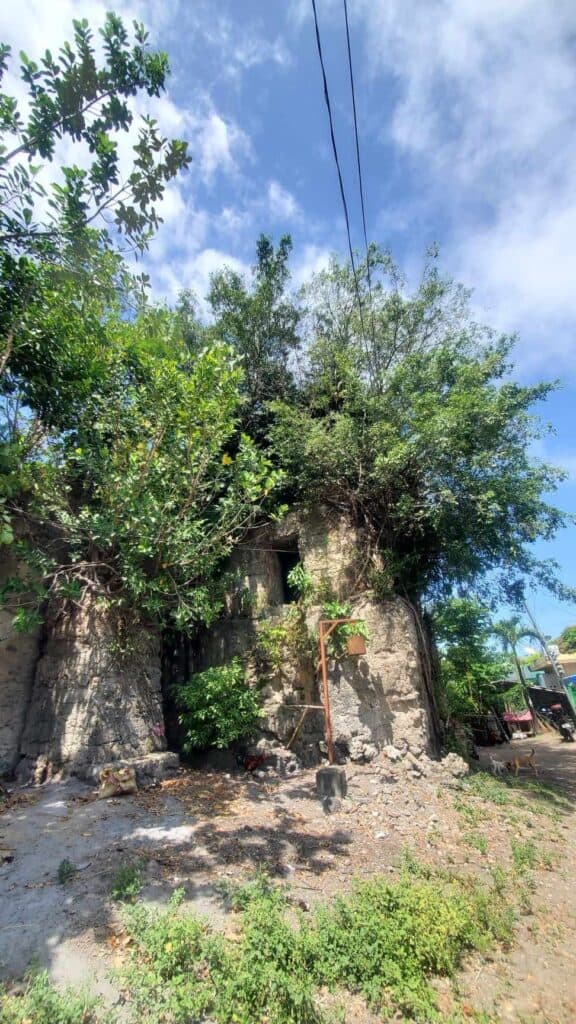Situated in Barangay Baybay, Tiwi, Albay, a historical ruin lies at the back of the municipal office and Tiwi town plaza—an abandoned church building called “Sinimbahan.”
This ruin was built with stones and volcanic rocks, carrying a unique story to offer from the past of the town.
Looking back at the history of Sinimbahan, the abandoned church marked the old center of Tiwi, which originally began as Tigbi. The ruin was established in 1658 and originally administered by the Franciscan priests from the St. Anne parish of Malinao.
However, its construction’s date is unclear, but evidence suggests that it was likely built before the Franciscans left to administer the Malinao parish in 1696.
Beside Sinimbahan stood a friary or parish house (case parroquial) where Franciscan friars temporarily resided, which may indicate that the church served as a central hub for religious activities in the area.
The construction of Sinimbahan was described as “Earthquake Baroque”—designed to survive an earthquake and wars. It served as a fortress of protection from both armed invasions and earthquakes.
In fact, massive buttresses on one of its side walls provided stability, and the bell tower doubled as a watchtower (baluarte) to keep an eye out for any seafaring raiders. It was also documented that when the villagers formed a defense against piratical invaders, cannons were set up atop the bell tower and friary.
Through the lens
Residents of the town have their own conflicting narratives of what really happened to the church.
Some believe that the abandoned church was bombed during the Spanish colonial period, and due to a lack of support, the church was never reconstructed.
However, Noel Cipcon, 43, a resident of Barangay Baybay, shared another side of the story. Cipcon claimed that Sinimbahan was not bombed by the Spaniards but rather burned down a long time ago.
“Ang aram ko kang history kaini, nasulo ini. Naano ini kang 1651, Spanish time, dae man ini binomba ta kun binomba ini sabog ini [gabos],” Cipcon said in an interview with Bicoldotph.
(“What I know about the history [of the church] is that it was burned in 1651 during Spanish time; this was not bombed because if it were bombed, it would be completely destroyed.”)
On the other hand, the Municipal Tourism Culture and Arts Office (MTCAO) of Tiwi cannot confirm these speculations since they are solely relying on its historical record in general, stating that it was tragically destroyed during the Moro raid in 1841–1846.
This raid resulted in the reconstruction of the town center of Tigbi, which was then rebuilt in a new place in 1880 and thereafter renamed Tiwi.
Today, a new parish church, which was located at the front of Tiwi Plaza, was dedicated to St. Lawrence the Martyr, while the remnants of Sinimbahanan still stand in its area amidst the modern life surrounding it.
Sinimbahan at present
In 2019, the Sinimbahanan was declared by the National Museum as “important cultural property.”
Efforts were still made in the past years to conduct a weekly mass in Sinimbahanan, but were halted after some time.
Upon visiting the ruin, one can still view the remnants of the church structure. Visitors can still see some old tiles placed on its ground, the earliest window, and other fragments from the time when the structure still posed its original functions.
The sacred statue of the Blessed Virgin Mary was still placed in the upper middle of the wall. Along these are the bricks and windows filled with growing leaves; the holy table (altar) and walls were aesthetically wrapped by the sprouting roots of banyan.
From the recorded documents, an old pottery business inside Sinimbihan thrived in the previous years. However, in present times, visitors will only find residents having chitchats around its interior and unfortunately serves as a garage for some vehicles.
According to John Albert Fabrero, MTCAO operations officer, the property of the ruin was still with the Diocese of Legazpi, highlighting that they are still waiting for their agreement to execute further plans to preserve Tiwi ruin.
“May plano kami once na mag-agree sila. Ang pinaka-priority kaito siyempre dapat mai-relocate muna su mga yaon sa premises lalo na sa may butter zone tanganing maiwasan na talaga si pagka-damage kaito. Siyempre siguro makudalan arog kaiyan su idea, pero wara po ako aram na may budget iyan ta dae mi man ngani siya pa pwedeng gastuson sa ngunyan ta private property pa siya, wara pang agreement,” he said.
(“We have plans once they agree [to MOA]. Of course we will prioritize first the relocation of those who are in the premises of the area, especially those who are in the butter zone, in order to avoid its damages. Maybe we can fence off its area; that’s the idea, but I am not sure about the budget because even if we have it, we cannot spend it for now since the area is still private property and there hasn’t been an agreement yet.”)
Knowing that it was a cultural property, residents of barangay Baybay are still holding onto hope for its proper preservation despite being located at the back of the center town.
They claimed that the reconstruction may endow the residents with great opportunities to establish their own businesses once devotees visit the treasures of Sinimbahan.| Alliah Jane Babila, Lyzha Mae Agnote



